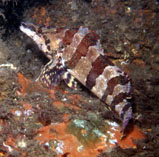| Family: |
Zaniolepididae (Combfishes), subfamily: Oxylebiinae |
| Max. size: |
25 cm TL (male/unsexed); max. reported age: 8 years |
| Environment: |
demersal; marine; depth range 0 - 49 m |
| Distribution: |
Eastern Pacific: Kodiak Island, Alaska to Point San Carlos, central Baja California, Mexico. |
| Diagnosis: |
Dorsal spines (total): 16-16; Dorsal soft rays (total): 14-16; Anal spines: 3-4; Anal soft rays: 12-13; Vertebrae: 36-39. Dorsal rayed part higher than spinous part. Caudal gently rounded. Anal notched between spinous and rayed parts, well incised (Ref. 6885). Head with scales; one fleshy cirrus above each eye and a pair on the occiput; gill membranes joined, free of isthmus. Body with 7 dark vertical bands. Pelvic fin of moderate length, not reaching the anus (Ref. 48751). |
| Biology: |
Found in rocky areas, from the intertidal to 49 m (Ref. 2850). Sleeps on the oral disc, leaving the anemone (Urticina lofotensis) by day but returning every night (Ref. 45560). Commonly encountered hovering motionless by divers (Ref. 2850). Feeds on crustaceans, polychaetes, small mollusks and bryozoans (Ref. 4930). Neither anterolateral glandular grooves nor venom gland is present (Ref. 57406). |
| IUCN Red List Status: |
Least Concern (LC); Date assessed: 14 December 2020 Ref. (130435)
|
| Threat to humans: |
harmless |
| Country info: |
|
Source and more info: www.fishbase.org. For personal, classroom, and other internal use only. Not for publication.

